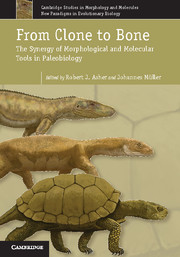Book contents
- Frontmatter
- Contents
- Contributors
- 1 Molecular tools in palaeobiology: divergence and mechanisms
- PART I Divergence
- 2 Genomics and the lost world: palaeontological insights into genome evolution
- 3 Rocking clocks and clocking rocks: a critical look at divergence time estimation in mammals
- 4 Morphological largess: can morphology offer more and be modelled as a stochastic evolutionary process?
- 5 Species selection in the molecular age
- PART II Mechanisms
- 6 Reconstructing the molecular underpinnings of morphological diversification: a case study of the Triassic fish Saurichthys
- 7 A molecular guide to regulation of morphological pattern in the vertebrate dentition and the evolution of dental development
- 8 Molecular biology of the mammalian dentary: insights into how complex skeletal elements can be shaped during development and evolution
- 9 Flexibility and constraint: patterning the axial skeleton in mammals
- 10 Molecular determinants of marsupial limb integration and constraint
- 11 A developmental basis for innovative evolution of the turtle shell
- 12 A molecular–morphological study of a peculiar limb morphology: the development and evolution of the mole's ‘thumb’
- 13 Manus horribilis: the chicken wing skeleton
- Index
- Plate-section
- References
2 - Genomics and the lost world: palaeontological insights into genome evolution
Published online by Cambridge University Press: 05 November 2012
- Frontmatter
- Contents
- Contributors
- 1 Molecular tools in palaeobiology: divergence and mechanisms
- PART I Divergence
- 2 Genomics and the lost world: palaeontological insights into genome evolution
- 3 Rocking clocks and clocking rocks: a critical look at divergence time estimation in mammals
- 4 Morphological largess: can morphology offer more and be modelled as a stochastic evolutionary process?
- 5 Species selection in the molecular age
- PART II Mechanisms
- 6 Reconstructing the molecular underpinnings of morphological diversification: a case study of the Triassic fish Saurichthys
- 7 A molecular guide to regulation of morphological pattern in the vertebrate dentition and the evolution of dental development
- 8 Molecular biology of the mammalian dentary: insights into how complex skeletal elements can be shaped during development and evolution
- 9 Flexibility and constraint: patterning the axial skeleton in mammals
- 10 Molecular determinants of marsupial limb integration and constraint
- 11 A developmental basis for innovative evolution of the turtle shell
- 12 A molecular–morphological study of a peculiar limb morphology: the development and evolution of the mole's ‘thumb’
- 13 Manus horribilis: the chicken wing skeleton
- Index
- Plate-section
- References
Summary
A consilience of genomics and palaeontology: palaeogenomics
Although genomes are the primary source of heritable information in organisms, over 99% of it has vanished due to pervasive extinction throughout the history of life (Raup 1992). The ability to ask and answer questions (even small ones) about the genomes of extinct organisms opens vast uncharted avenues of research. If one considers palaeontology a subdiscipline of biology, then it is the only biological subdiscipline that uses historical data (fossils) directly for the creation and testing of hypotheses. Palaeontology can bring to genomics direct evidence from the past in the same way it informs ecology and organismal biology about past environments and forms. Palaeontology reveals extinct lineages and morphologies otherwise unknown in extant species, and it can help delineate the limits and scope of form and/or function. It can expose patterns of change over long periods of time, or even lay bare past biological interactions, environmental conditions and biogeography. Palaeogenomic research attempts to integrate these lines of evidence with whole genome data. Although a nascent field, palaeogenomics has already provided insights intractable by looking at data from extant species alone, such as the Neanderthal contribution to the genome of modern humans (Green et al. 2010). Palaeogenomics can also help find regions of reduced polymorphism around a gene containing a recently adaptive mutation (the mutation ‘sweeps’ to fixation carrying linked sequences with it before recombination breaks the region apart – creating what is known as linkage disequilibrium; Figure 2.1).
- Type
- Chapter
- Information
- From Clone to BoneThe Synergy of Morphological and Molecular Tools in Palaeobiology, pp. 16 - 37Publisher: Cambridge University PressPrint publication year: 2012



